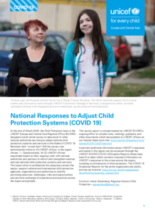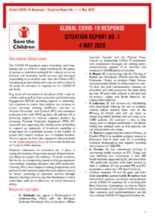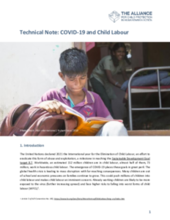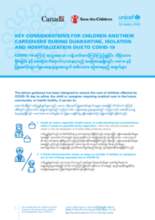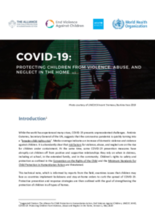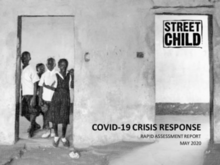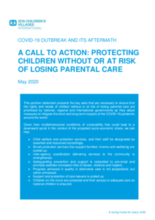This section highlights tools and resources for child protection in the COVID-19 pandemic.
Displaying 121 - 130 of 264
This webinar examines the technical note on protecting children from violence, abuse, and neglect in the home as countries implement lockdowns and stay-at-home orders to curb the spread of COVID-19.
UNICEF Europe and Central Asia Regional Office (ECARO) designed a brief online survey to take stock of what national authorities are doing to adjust national child protection systems and services in the wake of COVID 19. This report aims to synthesizes the responses across the region; support national and international child protection agencies, organizations and authorities to identify promising practices, challenges, risks and opportunities; and promote exchange of experience and practices across the region and globally.
This situation report describes progress on key areas of Save the Children's response to the COVID-19 crisis.
This technical note offers guidance and information to practitioners and policy-makers on child labour issues during and after COVID-19 and what actions can be taken.
This guidance - written in English and Burmese - has been designed to ensure the care of children affected by COVID-19 in Myanmar due to either the child or caregiver requiring medical care in the home, community or health facility.
This document - written in English and Burmese - presents guidance on how to ensure continuity of child protection case management service provision during the COVID-19 crisis in Myanmar.
This technical note, which is informed by reports from the field, examines issues that children may face as countries implement lockdowns and stay-at-home orders to curb the spread of COVID-19.
This video from REPSSI describes the difficulties of providing care services during the COVID-19 pandemic and how care workers can be supported during this time.
This rapid assessment was conducted with 12,100 respondents across 13 countries, aimed at understanding the needs and gaps in assuring assistance for affected children and communities during the COVID-19 crisis.
This position statement presents the key asks that are necessary to ensure that the rights and needs of children without or at risk of losing parental care are prioritised by national, regional and international governments as they adopt measures to mitigate the short and long-term impacts of the COVID-19 pandemic around the world.

